Beginner’s Guide to Guitar Scales: Learn Your First Scale and Beyond
If you’re a beginner guitarist, chances are you’ve fooled around and learned a scale or two. Let’s go beyond that dabbling phase. In this first, of a series of articles, I’d like to give you a fresh start by teaching guitar scales and systems from the ground up.
When you start to understand scale “systems” (not just isolated patterns), the entire fretboard really opens up and you’ll be able to dance all over the neck like it’s your personal playground. That’s when playing the guitar starts to become extremely fun and enjoyable.
Let’s dive into this beginner’s guide so you can begin to build a foundation that will shape the way you play for many years to come.
What Is a Scale?
A scale is a series of notes, played in ascending or descending order from one octave to another. It’s a melody. Every scale will follow a specific formula of a sequence of intervals between notes. These are almost always sequences of whole-steps and half-steps.
Why Learn Scales?
As I mentioned above, scales form the foundation of all music. Once you understand scales, you’ll be equipped to understand how music is constructed. By learning how to play scales on the guitar, you’ll be able to start writing music that makes sense to the ear. You’ll stop guessing why certain notes sound good together. You’ll just know it’s all part of a scale.
Learning scales will allow you to become an improvisor on the guitar. If you ever want to be able to play lead guitar and crank out solos, you need to know scales. They are the building blocks of melodies. If you ever want to be a blues, or jazz musician, you definitely have to know the scales.
Scales Also Help Us Build Chords
When you stack notes of a scale on top of each other, we end up with “diatonic chords” of a scale. Knowing the diatonic chords of a scale is what allows us to write chord progressions that make sense. It’s how we start playing in a certain “key.” We’ll discuss this topic further in another article.
Types of Guitar Scales
There are a lot of scales out there, but let’s cover the most common and essential ones to start with.
Major Scale
The Major Scale is the foundation of all Western music. What does that mean? It means the notes of the Major Scale are what all melodies are created from and the structure is how all chords are formed.
When you hear a melody, you’re most likely hearing the notes of (or a mode of) the Major Scale. When you hear a chord progression, you’re likely hearing the diatonic chords formed from the Major Scale.
There are exceptions to these rules when you start branching off into the blues and jazz genres but I’ll cover those scales in other articles. Most forms of rock and popular music are built from the foundation of the Major scale.
Here is the sequence of intervals for the Major Scale, from one octave to another, in ascending order.
- Whole-step
- Whole-step
- Half-Step
- Whole-step
- Whole-step
- Whole-step
- Half-step
To further illustrate this, here is a G Major Scale on a Single string. Can you see the pattern of whole-steps and half-steps?
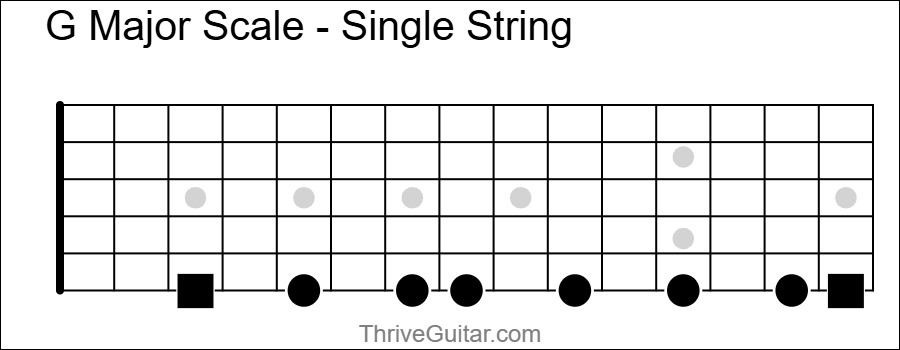
Minor Scale (Natural Minor)
Most of the music you hear today is derived from the Major Scale or a mode of the Major Scale. The Minor Scale, or “Natural Minor” scale is the best example of this. The Minor Scale is simply the Aeolian mode (6th degree) of the Major Scale. It’s the Major Scale, but with the tonic note shifted up (or down) to the 6th note of the Major Scale.
The Major Scale is known as the “Ionian” mode. The Natural Minor scale is known as the “Aeolian” mode. The Minor Scale is the bread and butter of rock music. The solos in the songs Stairway to Heaven, All Along the Watchtower, Comfortably Numb, and countless other rock songs are all derived from the Aeolian mode.
Here is the sequence of intervals for the Natural Minor scale.
- Whole-step
- Half-step
- Whole-step
- Whole-step
- Half-step
- Whole-step
- Whole-step
To futher illustrate this, study the diagram below, with the scale beginning on the open 6th (low E) string.
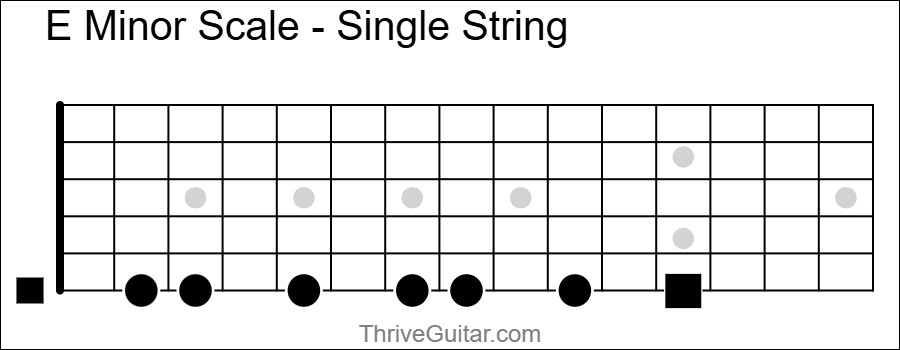
If you study this, you’ll notice this is simply the G Major Scale, with the tonic shifted down 3 half-steps. It shifts it down to the 6th degree of the Major Scale.
Modes of the Major Scale
The Major Scale can be altered by shifting the tonic note to a different note. The best example is the Aeolian mode from our Minor Scale discussion above. However, we can also play in other modes by moving the tonic to other notes, or “degrees” of the Major Scale.
Below is a list of the modes of the Major Scale, listed with Romain numerals since this is the most common ways the degrees of the Major Scale are depicted.
- I – Ionian
- II – Dorian
- III – Phrygian
- IV – Lydian
- V – Mixolydian
- VI – Aeolian
- VII – Locrian
Each mode creates a different “mood.” When you think modes, think moods. Each one is different and it’ll be your job to determine when to use each one through experimentation.
Don’t be intimidated by the thought of learning all the modes. It’s something that’ll come easier over time. They are all just variations of the Major Scale, so you don’t need to learn separate patterns. Like anything else, it’ll become easier with practice and time.
Pentatonic Scale
The Pentatonic scales are extremely popular and useful in many forms of music. You’ll hear them used in rock, country, and pop music. It’s also a popular beginner scale system to learn. It’s basically a hollowed out Major (or Minor) Scale.
The Pentatonic scale only has 5 notes per octave, hence the “Pentatonic” name. The Major Scale has 7 notes. The Minor Pentatonic Scale includes the 1st, 3rd, 4th, 5th, and 6th degrees of the Major Scale. The Major Pentatonic Scale includes the 1st, 2nd, 3rd, 5th, and 6th degrees of the Major Scale. Think of the Pentatonic Scales as Major or Minor Scales, but missing some notes.
The Pentatonic Scales are some of the most useful of all. You can use them in major or minor versions, similar to the Major Scale and Natural Minor Scale. The major and minor versions use the same scale patterns on the guitar, but we just have to shift the tonic note. I’ll show you all of the other patterns of the Pentatonic Scale system in a separate article.
Blues Scale
The Blues Scale is simply a Minor Pantatonic Scale with an added “blue” note. That blue note is a flattened 5th or b5 interval. The scale is very distinguishable from other scales. It has a very sassy tone and feeling. You’ll know it when you hear it. I’ll save further discussion of the Blues Scale for another article since it is a large topic.
Harmonic Minor Scale
The Harmonic Minor Scale is a scale that breaks some of the rules by having an interval of 3 half-steps in it. It is the same as the Natural Minor scale, except it has a Major 7th interval, rather than a Minor 7th.
This scale also has a very distinguishable sound to it. It is used in necoclassical rock and metal, as well as flamenco styles of guitar. Yngwie Malmsteen uses this scale and various modes of it in his music.
Learning Your First Scale Pattern
If you haven’t already learned any scales, let me give you a pattern to start with. This is the first scale I learned how to play. This is the G Major Scale in the open position (using open strings).
G Major Scale – Open Position
Here is the tablature for this scale position. It actually starts on an E note, with the tonic of G being on the 3rd fret, 6th string. I only portray it this way because I want you to learn the entire pattern and all of the notes. Just remember the scale actually begins and ends on the G notes. If you need help learning the notes of the guitar, see my article about this.
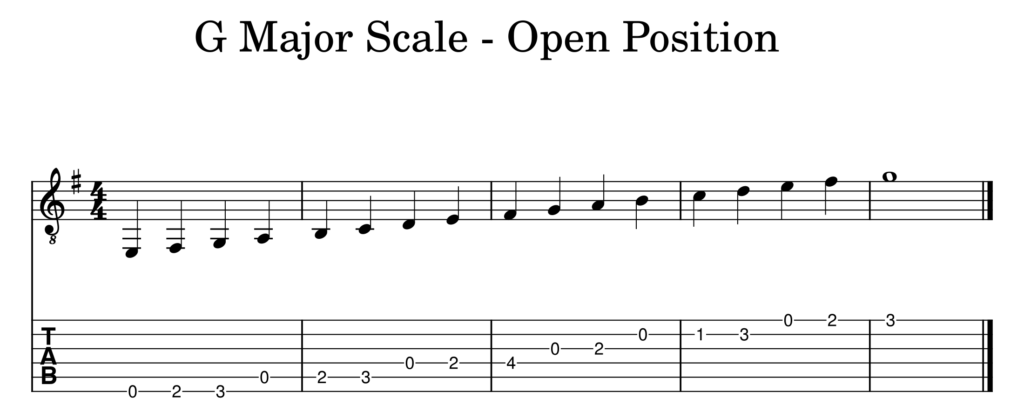
Here’s what it looks like on a fretboard diagram. Start memorizing this shape on the fretboard. This happens to the the G shape of the CAGED system I’ll discuss below.
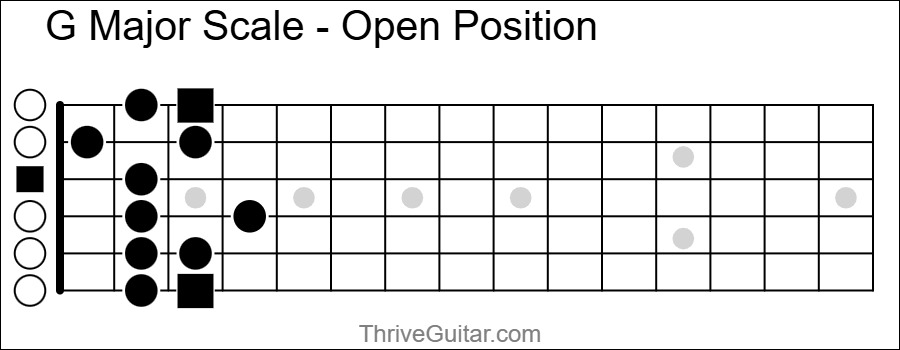
Bonus: G Major Scale On a Single String
Now that I’ve shown you that scale, let’s learn it a different way. Here is the G Major Scale on a single string. (This version only spans one octave).
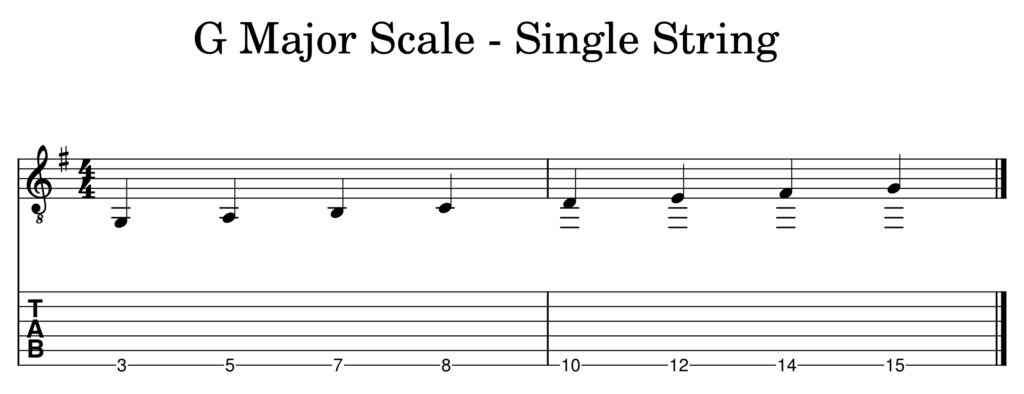
From a visual standpoint, here is what that looks like on the guitar.

Guitar Scale Systems
Once you know a single scale pattern, you’ll eventually ask yourself, “okay, now what?” This is where scale “system” comes in. They will help you learn how to connect the dots and play all over the fretboard. Let’s briefly discuss them below.
Single-String System
You may not think that knowing how to play a scale on a single string is very practical, but I’m here tell you…it is! Knowing how to play the Major Scale on a single string has been one of the most useful skills I have learned as a guitarist.
Learning scales on a single string helps you connect the dots between all of the patterns and positions. It gives you a lot of freedom. You can be improvising in a certain pattern, then decide you’re ready to break out of that position and ascend up the fretboard a bit to another pattern.
This gets really fun! Plus, you know what’s really fun about knowing the single string scales? Legato and finger tapping licks! Eddie Van Halen knew a thing or two about single string scales!
CAGED System
The CAGED system of scales is a good starting system for beginners to learn. It consists of 5 different patterns, each based on the notes of the open chord shapes of the C, A, G, E, and D chords. Since each of those chords use notes from the Major Scale, you can fill out the remaining notes of the scale and build scale patterns around them.
It gets really exciting when you’re able to play a scale in multiple patterns covering all 12 frets and beyond. When I was finally able to play the Major Scale in 5 different patterns this way, by memory, it felt like the doors had been unlocked. I think I learned them accidentally one night when I was fooling around. It was definitely an “ah-ha” moment. It all just clicked. I’ll help you learn this same system as well!
Pentatonic Scale System
The Pantatonic Scale system is another set of patterns based around the CAGED system, with some of the notes missing. Again, the pentatonic scales are just hollowed out versions of the Major and Minor Scales. These are good for position playing and improvising but also connecting pattern segments up and down the neck for various melodic runs.
3-Note-Per-String System
The 3-Note-Per-String system is one of the more tedious systems to learn, but provides a great return on the investment, especially if you want to play “shredder” type of licks. There are 3 notes on each string per pattern and there is more overlap in the notes from one pattern to another. There are 7 total patterns, each based on the modes of the Major Scale.
I highly encourage you to learn this system eventually, if you want to learn some really killer licks. Guys like John Petrucci, Paul Gilbert, and other highly technically advanced players are known for using this system of scales in their playing.
How to Start Getting Serious with Scales
Once you’ve memorized a scale or two, dabbled a bit here and there, it’ll be time to get serious and learn one of the systems. I recommend starting with the single string scale.
Step 1: Learn the Major Scale On a Single String
This is a no-brainer first step in my opinion. You don’t have to learn it alone either. You can learn it at the same time you’re tackling the CAGED system, for example.
Step 2: Learn the CAGED System
I had my initial success and breakthrough moments with the CAGED system. I highly recommend it for beginners who want to reach an intermediate level of playing and understanding of the guitar. It’s essential to know these shapes. You can use them for improvisation and learning useful arpeggio shapes as well.
I remember when I was able to take a couple scale patterns I already knew (that also belonged to the CAGED) and add in the other 3 to complete the system. It felt amazing when I was able to play in all 5 positions up and down the neck. I recommend this system for beginners.
Step 3: Add the Pentatonic Patterns
The Pentatonic Scale patterns are also highly useful if you want to connect the dots on the neck. I’m torn on whether or not you should learn the Pentatonic patterns first, or just go all in with the Major Scale first. I must admit, the Pentatonic patterns are not as useful for me as the Major Scale patterns, but they are still useful to know.
Step 4: Tackle the 3-Note-Per-String (3NPS) Patterns
Ultimately, you’ll probably want to learn the 3-note-per-string (3NPS) system of scale patterns if you want to play fast. They are so useful and practical to use when coming up with shredder style licks. Even if you don’t want to play fast, they are still highly useful to know because it helps you further your understanding if the fretboard.
Final Thoughts
The thought of learning all of these scales can be overwhelming, but it’s one of the most useful investments of your time on the guitar. Don’t think you have to learn all of these system and scales in a week, a month, or even a year!
Take this next year and just focus on one or two systems. Then take next year and build upon it by stacking another system or two on top of what you already know.
Just think, you’re probably going to be playing the guitar for the rest of your life. In the grand scheme, a couple years really isn’t that long. Don’t get in too big of a hurry. Take your time. Really focus on what you’re learning. Learn how to use these systems to your advantage.
Soon, the fretboard will seem like your personaly playground where you can freely express your musical ideas. I’m telling you, learning these scale systems are worth your time. Stay tuned for more articles and lessons on scales!
